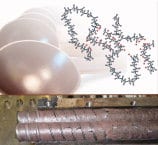Polymers from nonfossil fuel sources have once again become important, after many decades in which petroleum-based polymers have dominated the scene, though one must not forget that largely polymeric animal or wood products have been mainstays of human “engineering” for millennia. While not all renewably sourced polymers have a performance or cost profile that would yet enable them to compete with more traditional polymers, several of them are gaining ground from both points of view, especially when one factors in the added benefits with respect to CO2 emissions (although those do not always favor renewably sourced polymers, if the entire life cycle of the product is considered), as well as consumer preferences.
The special issue of the Journal of Applied Polymer Science on biopolymers and renewably sourced polymers gives a broad overview of the state-of-the-art in industrial and academic research in this booming field. We feature articles on polylactides, such as the article on PLA food packaging from Siracusa et al., polyhydroxyalkanoates, with respect to recyclability and performance in the paper by Zaverl et al., composites with renewably sourced fibers, for example for flame retardants as in the article by Nie et al., and the deployment of renewably sourced polymers together with biopolymers in biomedical applications, as in the paper by Jiao et al. The materials used range from the delicate (tea dust) to the gruesome (bloodmeal).
This flurry of activity does not necessarily generate materials (whether polymers or composites) that can compete with petroleum-based polymers, for a variety of reasons, whether the brittleness of PLA or its moisture absorption issues, or the undesired photochemical degradation of biocomposites. Likely, though, there will be room in the future for both biobased and petroleum-based polymers, and particular niches will go to the polymers that are most useful and cost-effective for that particular application. On the other hand, the improvement in properties of renewably sourced polymers in the last few years is undeniable, and industry is embarking on projects with an ever larger footprint in this area, further contributing to spearhead the research effort.
Another interesting aspect of research of biosourced polymers is that they allow the reuse of wastes from crops, such as banana fibers and rice straw, which would otherwise be landfilled. These materials not only do not interfere with the food pipeline, but they are also a stimulus to research in developing countries in which these plants are cultivated.



















